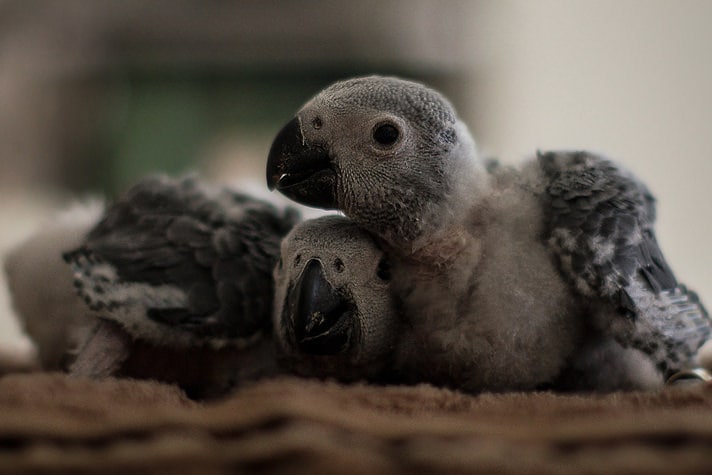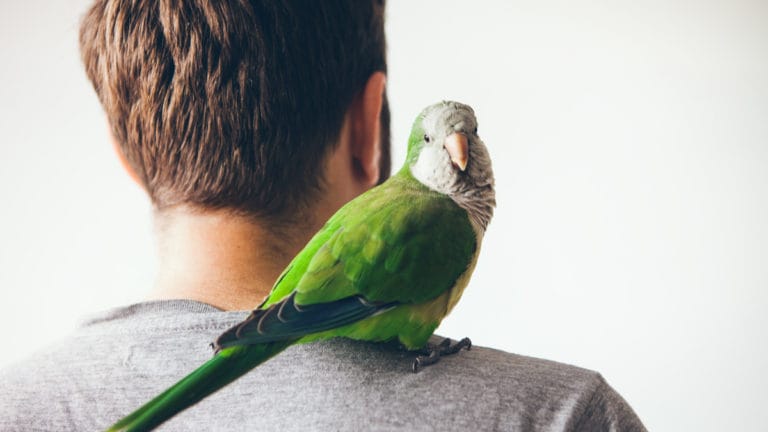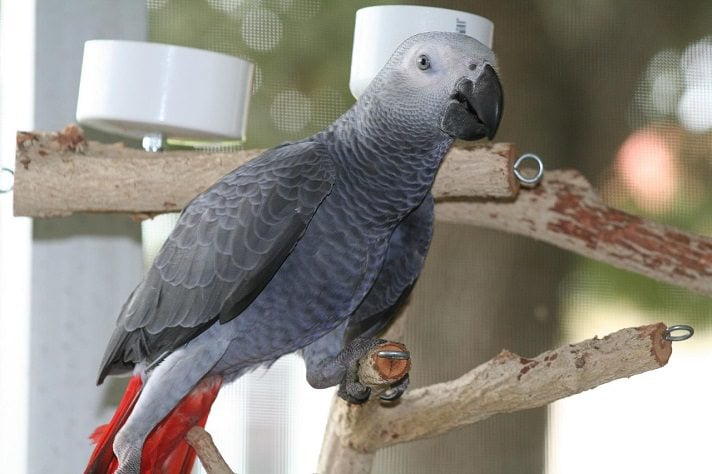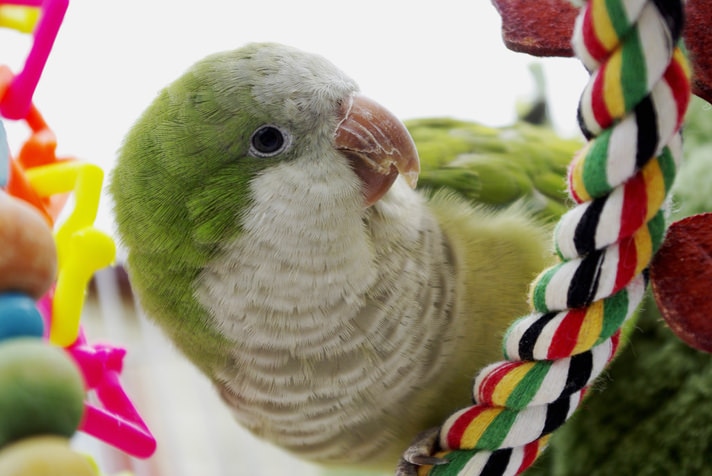Weaning is a wonderful, delightful and fascinating time in a young pet bird life. It is also the most important time, as it will significantly shape the way that a pet bird relates to its environment.
When hand-feeding parrot chicks, feed them as soon as their crops are empty or just before their crops empty. Once parrot chicks are on only two hand-feedings a day, they begin refusing formula, taking less and less at each feeding. They become increasingly difficult to feed as they refuse food; they would rather run off to play. They sling formula around the room or dribble huge puddles of baby food on their feet. This is when weaning begins.
Weighing Baby Birds
Weigh young birds every morning when their crops are empty. Record each pet bird weight and the amount of parrot bird food at each feeding. By reviewing the records, you can determine if it is safe to stop hand-feeding a chick and allow the chick to become food-independent. When the parrot chick progresses to only two hand-feedings a day, it will peak in weight and then begin to lose weight. After fledging, the parrot chick regains some of the lost weight, and then its weight stabilizes. Healthy young baby birds are round, chubby and cute, with fat toes and wing tips. They must burn off this baby fat in order to spread their wings and lift themselves into the air to fly (fledge). They practice by flapping their wings so hard that they scoot across the floor in a line or in circles.
Their refusal to eat can be terrifying, especially to the novice hand-feeder. The baby bird may begin to feel light and look terribly thin compared to the plump chick it was a couple of weeks earlier. The baby that once begged for food and pumped so furiously when fed now pulls away and refuses to eat. These times can be nerve-racking, yet I cannot stress how important it is not to force-feed a baby bird. Too many baby have been killed by well-meaning people who tried to force an uncooperative chick to eat.
Maintain weight records to be clear how much weight the chick has lost. Comparing weight records of chicks of the same species helps to determine if a particular chick is underweight for its age.
Weight loss after a baby reaches its peak weight should range from 10 to 25 percent, depending on the species. Large species and large chicks within a species lose a greater percent of their weight. If a baby loses too much weight, consult an avian veterinarian; an advanced aviculturist involvement may be necessary.
Offering Solid Foods
I offer solid foods just prior to fledging. Baby birds being raised by their parents would not have the opportunity to eat any solid food until they fledge, so it is the natural time for solid foods to be available. At fledging, chicks will remember items offered as food at this time for a lifetime. Therefore, offer a tremendous variety to fledglings.
You can tell which foods are eaten and which are not. Continue to offer foods that are ignored, but increase favorite foods so that the chicks begin to learn to eat well on their own.
Hungry parrots are a paradox; they often will not eat until they are offered something that they really want. A parrot chick that is begging for hand-feeding formula might not eat any solid food until it is hand-fed. Immediately after hand-feeding, it might consume an entire bowl of food.
I offer large pieces of corn on the cob to chicks that are just beginning to wean. At first they view the corn as a toy, jumping on it and mouthing it. They quickly discover that it has a smooth, bumpy texture and sweet-tasting kernels. Another wonderful weaning food is peas in a pod. The chicks love to pick up the pods and feel the peas inside. They instinctively tear open the pod and devour the peas. One of my favorite weaning foods is a mixture of mashed sweet potatoes with peanut butter and coconut milk. This soft, mushy combination can be fed warm and is a gradual step from formula.
Difficult Weanings
Some parrot chicks may refuse to become completely food-independent. Very few chicks will not attempt to eat some food on their own; however, they may continue to beg for hand-feeding. Some species simply take longer to wean than others. Hyacinth macaws and black palm cockatoos may take up to one year to wean. Cockatoos as a whole tend to be difficult.
Illness, injury or deformity can prevent the chick from weaning at a normal age, and that chick will not have the independence and confidence to wean at the appropriate time. Yet, even in the most extreme case I have seen, the baby eventually was able to eat by itself.
Single chicks are much more difficult to wean than chicks raised with clutch mates. In the wild, it is more difficult for the parents to feed all the chicks, and some may die. Becoming food-independent as quickly as possible increases the chance of survival for the entire clutch. The larger number of chicks encourages competition for food and thus instills independence.
If a baby is past weaning age and is showing no signs of becoming food-independent, take the chick to an avian veterinarian with experience in avian pediatrics. These chicks often have a mild infection that may not prevent them from growing normally, but prevents them from thriving without hand-feeding.
If a chick receives one small hand-feeding a day, it is consuming enough food by itself to meet the nutritional requirements for proper growth. Hand-feeding at this stage is a psychological dependency. If a healthy chick persists in begging for food, then reduce the amount of formula given, and slowly lower the temperature of the formula to 80 degrees Fahrenheit from the normal temperature of 101 to 110 degrees Fahrenheit.
When you eliminate a hand-feeding, use that time period to interact with the chicks and provide them with attention to develop poise and independence. Chicks also should be handed solid foods. In fact, birds should be offered healthy treats from the hands of many people throughout their lifetime. This helps keep birds sociable and friendly to many people and encourages birds to continue eating a healthy diet.
The Flight Connection
When a bird is about to fledge or is newly fledged, it becomes so difficult to control that some people decide to trim the bird wing feathers. Trimming the wing feathers of an unweaned bird is a big mistake. The chick will not understand that he cannot fly because his wing feathers are trimmed, and he will refuse to eat in order to lose weight and fledge.
Weaning will be prolonged, the psychological effects can be devastating, and the chick will never develop the strong muscles and bones, the good balance and the healthy respiratory system of a well-fledged chick. Do not trim a bird wing feathers until the bird is completely food-independent. A proper wing-feather trim allows the bird to glide gently to the ground.
After baby parrots fledge, their weight continues to drop for a short period of time. Once parrot chicks develop some skill in flying, they will beg for more food, because flying requires more energy and better nutrition than walking or perching. At this time, parrot chicks might look like adults, but they still are in a stage of rapid growth and will need the extra nutrition.
Behavioral Problems
If you force baby pet birds to wean, there is a strong possibility that they will develop behavioral problems. Those problems also might develop if hand-feeding continues well past weaning age.
It is vitally important that birds are weaned at the time that nature intended for them to become independent. Babies weaned at an improper age eventually may exhibit behaviors associated with a lack of self-confidence and fear, such as biting, excessive screaming and poor eating habits. Sexual behaviors will become problematic in birds that are hand-fed well into maturity.
Weaning Foods For Ill Birds
Warm, soft weaning foods can disguise medicines. The occasional offering of weaning foods with a spoon will accustom adult birds to accept food in this manner. Do not use a bent spoon or syringe, because it will encourage pumping and mimic hand-feeding.
Posted by: Chewy Editorial
Featured Image: Papooga/Flickr
Share:











